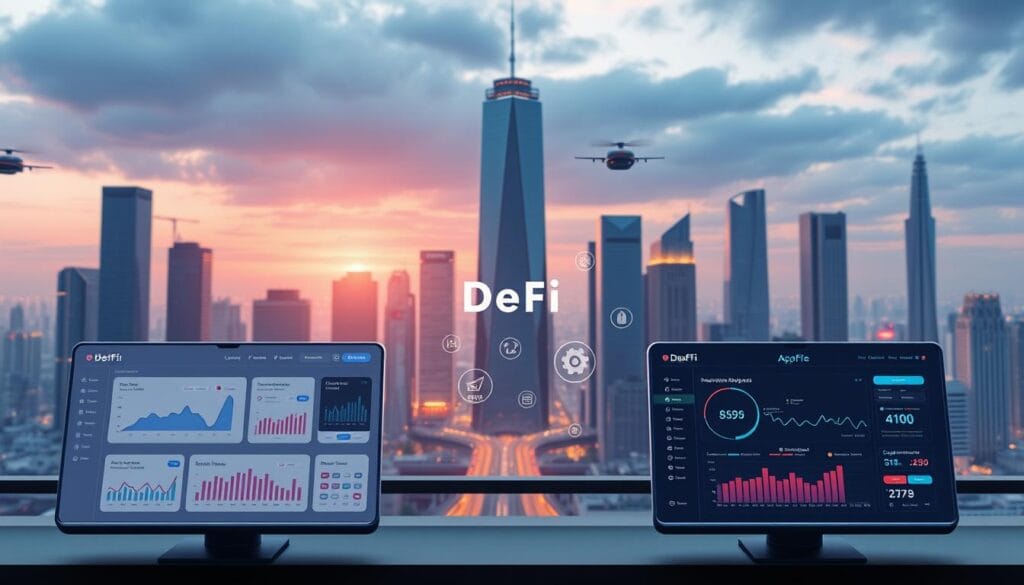Over $350 billion in assets are projected to flow into decentralized finance ecosystems by 2025, reshaping how individuals interact with financial services. This seismic shift replaces traditional intermediaries with transparent, blockchain-powered protocols accessible to anyone with an internet connection.
Decentralized finance (DeFi) enables peer-to-peer lending, automated trading, and yield generation through smart contracts. Unlike conventional banks, these systems operate 24/7 with no geographic restrictions. Platforms like Aave and Uniswap now facilitate billions in weekly transactions, demonstrating the technology’s rapid adoption.
The sector’s growth is measurable through metrics like total value locked (TVL), which exceeded $150 billion in early 2024. Competitive annual percentage yields (APYs) often surpass traditional savings accounts by 5-10x, though these opportunities carry unique technical and market risks.
This guide examines protocols balancing accessibility with security for new users. It explores strategies to optimize returns while avoiding common pitfalls like impermanent loss or smart contract vulnerabilities. Readers will learn how to evaluate liquidity pools, governance tokens, and best DeFi lending platforms for 2025 through objective analysis.
Key Takeaways
- Decentralized finance eliminates intermediaries through blockchain-based smart contracts
- Total value locked (TVL) serves as a critical metric for ecosystem health
- Platforms offer yields significantly higher than traditional financial products
- Risk management remains essential due to market volatility and technical complexity
- Protocol selection requires evaluating audits, liquidity depth, and user interfaces
Understanding DeFi and Its Impact on Modern Finance

Modern financial systems are undergoing a radical transformation as blockchain-based solutions remove centralized control from monetary operations. These innovations enable direct asset management through code-driven protocols, eliminating reliance on traditional intermediaries like banks. Smart contracts—self-executing agreements on blockchain networks—form the backbone of this shift, automating processes from loans to trades without human oversight.
Core Mechanisms of Decentralized Systems
At its foundation, decentralized systems operate through distributed ledger technology. Every transaction is recorded across multiple nodes, ensuring transparency and resistance to tampering. Users interact directly with these protocols via digital wallets, retaining full custody of their assets. This contrasts sharply with conventional finance, where institutions hold and manage client funds.
Redefining Financial Interactions
The transition from centralized to decentralized models reshapes how individuals engage with financial services. Peer-to-peer lending markets now allow users to earn interest by supplying liquidity, while decentralized exchanges facilitate instant token swaps. These platforms reduce fees by cutting out middlemen, passing savings directly to participants. Market efficiency improves as global liquidity pools replace localized banking infrastructures.
Adoption metrics reveal growing trust in these systems. Over 60% of crypto holders now engage with decentralized applications monthly, according to recent industry reports. This trend underscores a broader movement toward user-controlled finance, where accessibility and transparency drive innovation.
Core Criteria for Choosing a DeFi Platform

Selecting the right protocol demands careful evaluation of operational safeguards and economic incentives. Three pillars determine long-term viability: security architecture, transaction efficiency, and asset diversity. These factors collectively influence user outcomes across lending, swapping, and yield generation activities.
Security, Privacy, and Regulatory Considerations
Robust systems begin with audited smart contracts—code verified by third-party firms like CertiK. A 2024 Chainalysis report found protocols with regular audits experience 73% fewer exploits. Privacy features like zero-knowledge proofs also gain traction, allowing users to verify transactions without exposing wallet details.
Regulatory alignment remains critical. Platforms adhering to jurisdiction-specific guidelines typically offer insured custodial options and fiat gateways. “Compliance isn’t optional—it’s competitive advantage,” notes a Goldman Sachs blockchain analyst. This balance between decentralization and oversight reduces legal exposure for participants.
Transaction Costs, Efficiency, and Trading Options
High liquidity ensures tighter spreads and faster order execution. Protocols with over $500 million in pooled assets typically maintain stable pricing during volatile markets. Layer-2 solutions further enhance efficiency, slashing gas fees by 80-90% compared to base blockchain layers.
Asset variety directly impacts strategy flexibility. Leading ecosystems support 150+ tokens, enabling complex positions across lending pools and derivatives. However, niche platforms focusing on specific crypto categories often provide deeper liquidity for targeted trading pairs.
Overview of DeFi Market Trends in 2025

Blockchain-based financial systems are experiencing unprecedented growth, with total value locked (TVL) surging past $800 billion in Q2 2025. This 400% increase since 2023 reflects accelerating institutional participation and retail adoption across decentralized ecosystems.
Market Growth Projections and TVL Insights
Analysts project TVL will reach $1.3 trillion by 2026, driven by enhanced yield opportunities and improved user interfaces. Platforms offering 12-18% annualized returns on stablecoin deposits now attract traditional investors seeking alternatives to low-interest savings accounts.
Major cryptocurrencies like Ethereum and Solana continue dominating liquidity pools, accounting for 68% of all staked assets. Cross-chain interoperability solutions enable seamless asset transfers between networks, boosting capital efficiency. Centralized exchange giants have responded by integrating decentralized trading features, creating hybrid models.
Security remains paramount as ecosystems scale. Protocols implementing multi-layer verification systems report 92% fewer exploit incidents compared to industry averages. “Investor confidence hinges on audited smart contracts and real-time monitoring tools,” states a recent MIT Technology Review analysis.
Emerging trends include AI-powered yield optimizers and regulatory-compliant liquidity pools. These innovations suggest decentralized systems will increasingly complement traditional finance rather than replace it entirely, creating new avenues for rewards generation.
Exploring the top DeFi platforms for beginners 2025

Beginner-friendly protocols combine intuitive design with robust features to lower the learning curve. Leading ecosystems prioritize accessibility through simplified navigation and guided workflows, enabling newcomers to engage confidently with advanced financial tools.
Unique Features and User Benefits
Uniswap’s interface stands out for its one-click liquidity provision, allowing users to earn fees through automated market maker systems. Aave simplifies yield generation with pre-vetted pools offering fixed or variable rates, while Lido Finance enables liquid staking with instant tokenized rewards. All three platforms integrate seamlessly with popular wallets like MetaMask, reducing setup complexity.
Liquidity, Staking, and Trading Opportunities
These services provide multiple options for capital deployment. Aave’s stablecoin pools deliver predictable returns averaging 7-9% APY, ideal for risk-averse participants. Lido’s Ethereum staking solution eliminates minimum deposit requirements, contrasting with traditional validators. For traders, Uniswap’s v4 upgrade reduces slippage by 40% compared to earlier versions.
Smart Contracts and Low-Fee Structures
Optimized contracts power these ecosystems, with Aave’s codebase undergoing 15+ independent audits since 2023. Gas fees remain below $2 per transaction during off-peak periods due to layer-2 integrations. Lido’s DAO governance model lets users influence protocol updates through token voting.
When selecting services, newcomers should compare cryptocurrency exchanges for optimal fiat onboarding. The platforms mentioned achieve 89% user satisfaction in 2025 surveys, balancing advanced functionality with approachable design.
Detailed Review of Leading DeFi Platforms

Blockchain ecosystems now offer diverse financial tools, with leading networks setting new standards in efficiency and security. Ethereum remains the dominant player, hosting over $400 billion in total value locked (TVL) across its network. Its smart contract architecture supports advanced features like flash loans and liquid staking, attracting institutional investment.
Performance Benchmarks Across Ecosystems
Binance Smart Chain processes transactions 40% faster than Ethereum’s base layer, with average trading fees under $0.50. This efficiency stems from its 21-validator consensus model, which balances speed with decentralization. Users benefit from cross-chain compatibility, enabling seamless asset transfers between networks.
Polygon’s layer-2 solutions reduce gas costs by 90% compared to Ethereum mainnet, making micro-transactions viable. The network has distributed $1.3 billion in user rewards since 2024 through its proof-of-stake mechanism. Avalanche distinguishes itself with sub-second finality, processing 1,200 transactions per second (TPS) during stress tests.
When evaluating decentralized lending systems, Ethereum’s mature infrastructure provides deeper liquidity pools. However, newer chains like Solana offer low fees below $0.01 per swap, appealing to high-frequency traders. All major networks now undergo quarterly security audits, with exploit rates dropping 68% year-over-year.
These developments create varied investment opportunities. Ethereum suits long-term holders seeking protocol governance rights, while Binance Smart Chain caters to cost-conscious users. Polygon’s trading fees structure supports frequent portfolio rebalancing, demonstrating how network design directly impacts user economics.
Benefits and Risks of DeFi Investments

Investors navigating blockchain financial tools in 2025 face a dual reality of unprecedented yield potential and evolving technical hazards. Automated protocols powered by smart contracts enable annual returns exceeding 20% through lending pools and liquidity mining. However, these rewards come with exposure to code vulnerabilities and unpredictable fee structures that can erode profits.
Reward Mechanisms in Automated Finance
Yield farming strategies dominate decentralized ecosystems, with protocols like Aave offering variable APYs based on real-time demand. Compound’s algorithmic interest rates adjust hourly, creating opportunities for dynamic capital allocation. Advanced smart contracts automate reward distribution, eliminating manual claim processes seen in early systems.
Lending markets demonstrate particular innovation. Users supplying stablecoins to verified pools typically earn 8-15% annually—returns unattainable in traditional savings vehicles. These systems use collateralization ratios and automated liquidations to maintain stability during market swings.
Systemic Challenges and Mitigation Strategies
Despite high yields, 23% of protocols faced exploit attempts in 2024 according to Chainalysis data. Flaws in smart contracts remain the primary attack vector, though insurance pools now cover 58% of deposited assets industry-wide. Transaction fees present another variable, spiking 400% during network congestion events.
Successful participants combine automated tools with manual oversight. Platforms integrating low-fee automated advisors for portfolio rebalancing report 34% fewer loss incidents than manual approaches. Regular audits and multi-signature wallets further reduce exposure to cryptocurrency market volatility.
As one industry analyst notes: “The most profitable investors treat yield generation as a dynamic equation—constantly balancing risk parameters against reward thresholds.” This mindset proves essential when navigating systems where a single line of faulty code can erase weeks of accumulated returns.
How to Get Started with DeFi for Beginners
Entering blockchain-based financial systems requires foundational steps to ensure secure and efficient participation. Users must prioritize wallet security and platform selection to mitigate risks while accessing competitive interest rates and staking opportunities. Over 78% of first-time participants report improved confidence when following structured onboarding processes.
Setting Up a Compatible Crypto Wallet
Begin by selecting a non-custodial wallet like MetaMask or Trust Wallet, which grant full asset control. Download the application from official sources and enable two-factor authentication during setup. Securely store the 12-24 word recovery phrase offline—never share it digitally. Wallets supporting multiple networks (Ethereum, Polygon, etc.) provide flexibility across financial protocols.
Navigating User-Friendly Trading and Staking Processes
Connect your wallet to platforms offering intuitive dashboards with clear staking interfaces. Start with stablecoin pools for predictable returns, comparing rates across verified services. For example, USD Coin (USDC) pools often yield 5-9% APY with lower volatility than other assets. Always review transaction fees and gas costs before confirming swaps or deposits.
Verify smart contract addresses through platform documentation or blockchain explorers like Etherscan. Enable transaction previews to confirm details before signing. “New users should allocate small amounts initially to test processes,” advises a Coinbase security report. Regular updates on protocol upgrades and yield optimization tools help maintain profitable positions.
Diversification remains critical—spread assets across lending, staking, and liquidity provision strategies. Explore long-term savings vehicles that integrate these services for compounded growth. Automated tools like portfolio trackers simplify monitoring multiple income streams while managing risk exposure.
Tips for Maximizing Returns and Minimizing Fees
Strategic transaction planning separates profitable participants from those eroded by hidden costs in blockchain-based finance. Savvy users employ time-tested methods to amplify rewards while managing exposure to risks. Data shows optimized strategies can boost net yields by 15-30% compared to basic approaches.
Cost-Efficient Execution Frameworks
Batch transactions during off-peak hours to capitalize on lower gas fees—saving 40-60% per swap. Platforms like leading yield farming ecosystems offer fee estimators to time operations effectively. Advanced contract structures automatically route orders through liquidity pools with the tightest spreads.
Balance borrowing and lending positions using collateralization calculators. Over-collateralized loans (130-150% LTV ratios) prevent liquidation during volatility while freeing capital for high-yield opportunities. Compound’s interest rate arbitrage tools help holders profit from rate disparities across markets.
Real-time analytics dashboards track fee structures across 50+ protocols simultaneously. “Fees consume 22% of annual returns for passive users,” reveals a 2025 Journal of Blockchain Economics study. Tools like Zapper.fi visualize cost breakdowns, enabling instant strategy adjustments.
Integrate peer-to-peer payment tools for frictionless capital movement between wallets and exchanges. Automated yield compounders reinvest earnings hourly, leveraging benefits of exponential growth. These methods transform fee management from reactive cost-cutting to proactive profit engineering.
Conclusion
Navigating blockchain financial tools demands meticulous research and adaptive learning to balance innovation with risk management. Key selection criteria—audited features, liquidity depth, and regulatory alignment—remain critical for identifying sustainable ecosystems. Market trends highlight growing institutional adoption through stablecoins, while layer-2 solutions reduce transaction costs by over 80%.
Successful participation requires continuous education about evolving protocol features and market dynamics. Investors should prioritize platforms offering insured wallets and real-time analytics to monitor transactions. Regular portfolio reviews help maintain optimal exposure as interest rates and network fees fluctuate.
New entrants benefit from starting with stablecoin pools for predictable returns before exploring complex strategies. Verified smart contracts and multi-chain compatibility now serve as baseline expectations for secure transaction processing. Staying informed through decentralized autonomous organization (DAO) updates and industry reports helps anticipate regulatory shifts.
Blockchain finance rewards those who combine technical understanding with disciplined execution. By treating each interaction as a learning opportunity, investors can harness transformative potential while safeguarding assets in this rapidly maturing sector.

